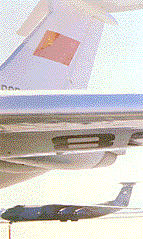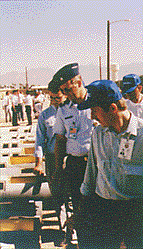| Briefings, Testimony, Decisions | ||
 U.S. and Soviet aircraft at Travis Air Force Base, California. |
Congressional
scrutiny of U.S. treaty responsibilities was intense. In
March and April 1988, four congressional committees held
hearings on the INF Treaty.17
The U.S. Constitution vests in the Senate the power to
give its "advice and consent" on all treaties
negotiated and signed by the President. Senior officials
from the Reagan administration testified, including the
Chairman of the JCS, the military service chiefs, the
Secretary of Defense, the Secretary of State, the
Director of the Arms Control and Disarmament Agency, and
the Director of the FBI. Practically every other week in
February, March, April, and May, General Lajoie briefed
the JCS, the Secretary of Defense, and senior officials
in the Defense Department on the status of inspection and
escort preparations. Lajoie appeared before congressional
committees, explaining planning and preparations for the
treaty mission. These briefings and testimony
incorporated the latest information from the technical
talks and provided current information on preparations
for extensive inspection/escort training exercises in the
United States and Europe in April and May. Similar
briefings were given to officials at the White House and
the Arms Control and Disarmament Agency. Sandwiched between these briefings and testimony was the decision on how to transport U.S. and Soviet inspection and escort teams. Understanding the airlift requirement was critical. Because of the structure of the treaty, the need would be especially intense during the first 60 days of inspections, the period known as the INF baseline. During that period, U.S. inspection teams would need daily flights into and out of Moscow and flights two or three times a week into and out of Ulan-Ude. At the same time, the U.S. portal monitoring team would be establishing its permanent inspection base at the Votkinsk Machine Building Plant in the Udmurt Autonomous Soviet Socialist Republic. This team also needed airlift support into and out of Moscow on a continuing basis. U.S. escort teams for Soviet inspectors also required airlift. When a Soviet team arrived at one of the entry points (for example, Frankfurt, Washington, or San Francisco), the U.S. escort team was obligated under the treaty to get them to the INF site within nine hours. This deadline began once the Soviet team chief specified the site to be inspected. For most Soviet inspections, OSIA would need a combination of air and ground transportation. In Europe U.S. missile sites were located in five nations--West Germany, Belgium, the Netherlands, Italy, and Great Britain. Commercial airline schedules would not meet the nine-hour time requirement. Air Force airlift planners and OSIA's transportation expert, Lt. Colonel Gerald J.K. Heuer, examined other options: leasing a fleet of commercial aircraft, using military airlift from the Air Force, or a combination of the two. The cost of leasing, over $50 million per year, was deemed excessive. The alternative was to assign the mission to the Air Force's Military Airlift Command (MAC). Following a briefing to the joint chiefs in late March, General Lajoie, Colonel McConnell, and Lt. Colonel Heuer flew to Scott Air Force Base, Illinois, on April 6, and met with General Duane H. Cassidy of MAC. General Cassidy said that MAC would take responsibility for transporting U.S. and Soviet teams, their equipment, and other logistical supplies. |

